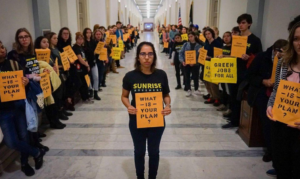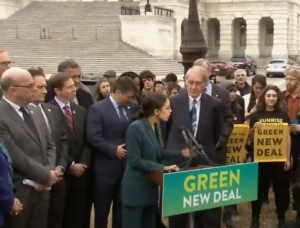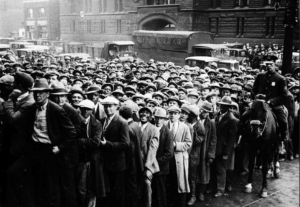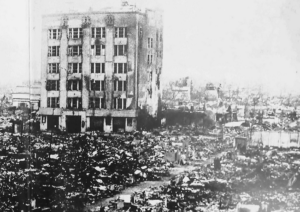The ruckus over the Democrat’s Green New Deal
Linking climate change with economic inequality
Some democrats in the US House of Representatives and Senate recently introduced a Resolution “Recognizing the duty of the Federal Government to create a Green New Deal.” Beyond the knee-jerk condemnation by Republicans, the Resolution has created a lot of buzz, curiosity, questioning, criticism, and concern.
Before delving into just what the Green New Deal (GND) is, we should clarify what a Resolution is. Basically it is a document that expresses the will or interests of Congress, or a branch of Congress, on a particular subject. It can be designed as a piece of legislation or more an expression of principles, opinions, goals and ideals. The current Resolution is non-binding and an expression of ideas, with supporting goals. It resembles more a party platform, with aspirations, rather than a legislative Programme of Government. That characterisation should not be read to dismiss or diminish the Green New Deal Resolution. We all could use some aspiration these days.
The GND confronts two of the most pressing challenges — climate change and growing income inequality, with wage stagnation. It also links them together in the one resolution with the overarching goal of decarbonizing the planet and the economy. The GND also grew out of a youth Sunrise Movement to stop climate change and create millions of good jobs in the process.

The Resolution sets out a Preamble that includes a series of Whereas clauses that offer factual and historical predicates for the growing problems from climate change and economic inequalities that disproportionately impact “frontline and vulnerable communities” and that require a national, social, industrial and economic mobilization as seen in President Roosevelt’s New Deal (post Depression) and World War II.
It cannot be said the Resolution lacks ambition. With regard to climate change the goals and projects are not revolutionary as they have been advanced for a number of years to define the scope of action necessary to address the increasingly threatening impacts from climate change.
Following the Preamble, the Resolution describes a series of goals and projects that will be promoted by the sponsors through legislation, or at least serve as the basis for discussions within Congressional committees to deal with climate change and economic policies.

Rep. Alexandria Ocasio-Cortez (AOC) and Sen Ed Markey
For climate change, examples of goals include net-zero greenhouse gas (GHG) emissions, including 100% of power through clean, renewable and zero-emission energy sources, through a 10-year national mobilization. This transformation will rely on a just transition, where those working in the fossil fuel industries and agriculture, and other sectors, will be provided support and retraining to adjust to the more sustainable society toward which the Resolution reaches. In addition, greater emphasis will be placed on developing more sustainable infrastructure and energy efficiency in homes and businesses. The means for achieving GHG reductions and a sustainable economy are familiar and reasonable, though a 10-year timetable is perhaps overly ambitious.
The new mobilization will also transform the economy through jobs and prosperity in particular for the frontline, vulnerable communities that have been suffering from wage stagnation and income inequality for decades. Certainly these sectors of society desperately need, and deserve, such ambitious goals. There are a few expressions of goals that do stretch the political calculus in “guaranteeing a job with a family-sustaining wage, adequate family and medical leave, paid vacations, and retirement security to all people in the United States,” and the promise “to provide all people in the United States with high-quality health care; affordable, safe and adequate housing; economic security; and clean water, clean air, healthy and affordable food, and access to nature.” None of the goals or projects is subject to cost estimates in the Resolution.
These last few examples, and a few others of like scope, are what triggered the Republicans to scream SOCIALISM. But then they shout that whenever anyone suggests any income and money being more evenly distributed. Indeed, they tend to see even social security as some form of socialism.
David Roberts of Vox has posted a series of extended and thoughtful analyses of the evolution of the NGD, its current form, and possibilities and risks. Roberts also adds what he thinks is missing, including a critical focus on density and public space.
Given the nature of the Resolution, politicians and supporters can pick and choose which elements they support. One could embrace the climate change goals and projects and pass on the economics, or vice versa. But there clearly are political risks in linking together in one proposal the many hurdles in trying to develop support for climate actions and for a fundamental transformation of the economy.

There also are some weaknesses in the choice of historical examples — the New Deal and World War II — that the proponents offer for mobilizing, at least when it comes to the fight against climate change. The New Deal followed from, and was a response to, the Great Depression that for a number of years had wrecked the national economy and devastated the lives of most people in the country. The mobilization for WW II was instituted to fight and destroy a clear common enemy, after years of that enemy invading and destroying close allies of the US, and after Pearl Harbor and the atrocities of the war.
We’re now being asked to mobilize to fight catastrophic, civilization-ending, extinction-inducing climate changes that increasingly seem inevitable but are still, at their worst level, decades and longer away. Extreme weather events are beginning to convince many that climate change is real and must be dealt with, but still these events are not, at the moment, comparable to the imminent threats and despair felt during the Depression and WW II.

And as in WW II, is there an agreed-upon enemy of climate change actions? It seems at times politically expedient to search for a convenient enemy to blame for our climate troubles. Certainly the fossil fuel interests qualify to some extent, as do vested interests in agriculture and other economic sectors. The problem is that climate change is the result of all of us wasting our natural resources; conspicuously consuming whatever we can get our hands on; relying on fossil fuels for heating, air conditioning, driving, flying and eating; and, opposing renewable energy and bicycles lanes when they block our views or inconvenience us.
It’s not easy recruiting people to join an army to fight themselves.
Sources:
HOUSE RESOLUTION: Recognizing the duty of the Federal Government to create a Green New Deal. bit.ly/2Sgjt3r
David Roberts, “This is an emergency, damn it: Green New Deal critics are missing the bigger picture,” Vox (23 Feb 2019). bit.ly/2tAc0gM
David Roberts, “There’s now an official Green New Deal. Here’s what’s in it: A close look at the fights it picks and the fights it avoids,” Vox (7 Feb 2019). bit.ly/2Bprs3M
David Roberts, “The Green New Deal, Explained,” Vox (7 Feb 2019). bit.ly/2LtVmHN


No comments yet, add your own below